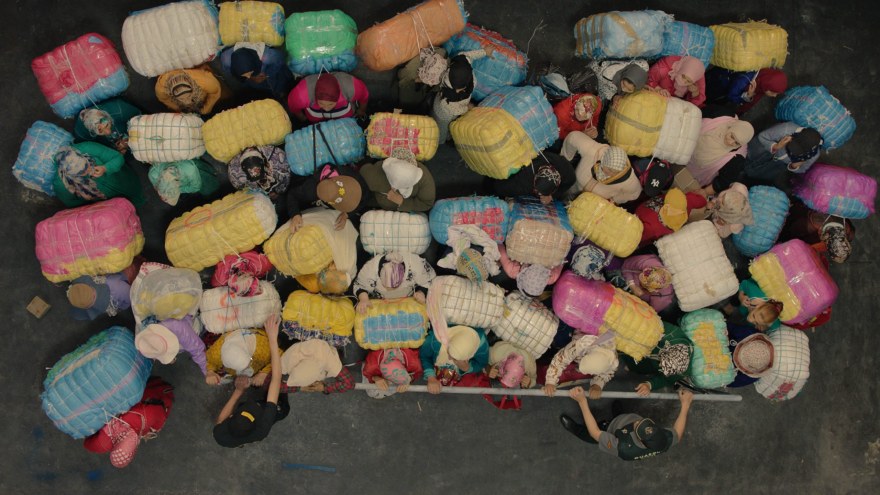Night cap with Bab Sebta
Interview with Randa Maroufi, director of Bab Sebta
The film is dedicated to your father. Could you tell us a bit more about what he did?
My father was a customs inspector until the end of the 90s. He worked mainly in the Laâyoune, Casablanca and Marrakech airports. Many members on my mother’s side of the family are from the north and work in import/export, customs and the border at Sebta. There have been times when we’ve obtained goods that had been seized by customs at Sebta. It’s an environment that I’m pretty familiar with.
What other research did you undertake?
I lived in the Tangiers region for many years and I studied for 4 years at the National Institute of Fine Arts at Tétouan. I had always noted the Spanish influence in this region, practically omnipresent, that you find in the regional dialect, the lifestyle and in particular in the consumer culture. In December 2015, I had the opportunity to stay at the artists’ residence in Trankat with an invitation from Bérénice Saliou, the current artistic director of ICI. I spent three weeks going back and forth by foot and by car observing the “ballet” of people around the border at Bab Sebta. The very particular territory of Ceuta creates unusual human relationships. There’s a loss of orientation, a madness of place.
Tell us a bit about the reconstruction of the scenes. How did the shooting go?
Bab Sebta is a series of reconstructed situations observed at the border of Sebta. As it is strictly forbidden to take pictures (as I had hoped to do) at the border, I chose to approach the project from a ‘conceptual’ angle. The film is shot entirely in a studio at Azla (a former mortadella factory) with 2 different points of view, a zenith and a frontal, and with people who really work at the border as well as local residents. It wasn’t difficult to have smugglers play their own role even if they operate in the informal sector. From the start, I created a bond of confidence with them by explaining that we were going to work together, that it was a collaboration in a professional setting. The people were very motivated because the subject interested them, and it amused them to play their own role in an enclosed space. They viewed this experience with much pleasure. I gathered interviews during the scouting. The set for the shooting was a bit under 50m2 with two cameras. The only thing I asked the actors to do was not to go outside of the frame. I gave them some situations and let them interpret them. In the film, we see three different moments where the men and women carrying merchandise, but also other people (tourists, others) are crossing the border. There are moments where they are waiting, moments where they prepare merchandise in the hangar, the moment that I call “freedom” where a human avalanche occurs. The formal and theatrical dimension of the film is a guarantee of freedom regarding the subject. I wanted to distance myself as much as possible from the typical images in the media that cover this place to enable the people being filmed to express themselves in a space and time other than that of the border. By being far from the real border, I wanted to give the workers an importance that they have to a far lesser degree in the real setting.
Can you explain your choice for the voice-over and the succession of different voices?
First there are the smugglers’ testimonials that I recorded when I visited them in 2015, and then the testimonials of people who used to work in contraband at the border including my cousin and his friend. After filming, when we were editing the sound, I rewrote the Spanish voice using articles from the press as inspiration and I had a Moroccan friend read it. At the same time, I also interviewed my brother’s father-in-law, a retired customs officer from my father’s generation, who told me stories that happened at the border at Melilia. I also wrote a piece that I asked him to recite in addition to his own testimonial. There’s a mix between true stories and fragments of fiction. I wanted to have voices of people who have different statuses, but also a “fragile” status like the Spanish voice where you don’t know if she is with the Spanish or Moroccan authorities and is lost despite having worked in Ceuta for 13 years and, in the end, she explains that she was arrested one day at the border because she was drawing. That could indeed be any person at the border, an enforcement officer, myself, … The aesthetic and formal dimension of the film could overtake it. The raw voice of the testimony balances that out.
What do you want to express through the film?
My aim is to transcribe the very distinct tension felt in this small territory which separates Africa from Europe but also, more generally, a state from the world.
Would you say that the short film format has given you any particular freedom?
I believe that my proposals cannot be adapted to the feature length format. There is often a significant formal bias. You mustn’t bore the spectator. And even myself, I would get bored and that is the reason why I don’t think I’ll move on to feature length films, not for the time being at any rate, the short format suits me perfectly.
Bab Sebta is being shown in the National Competition F10.








